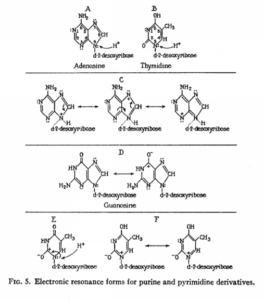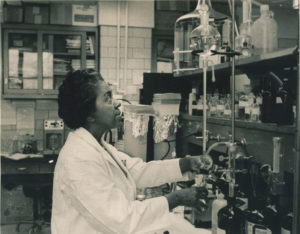How would you feel if you knew your work inspired hundreds, maybe even thousands of rising scientists to pursue the career that was meant for them. If you knew that some young kid would look at your research, your pictures of you working in a lab, and says “ I want to be just like them one day!”, wouldn’t you feel overjoyed, proud, or even grateful that you were able to get this far in your career? Even though there is little recorded history to how Marie Maynard Daly felt, I think these would be her feeling for being one of the most impactful African-American scientists that paved the way for many scientists from behind the scenes. Welcome to the second installment of my series, Hidden Figures Beyond, where I talk about scientists in underrepresented groups that made an important impact on the world of science. Today’s article is one I’ve been excited to write about since I joined this group. Today I’ll be talking about Marie Maynard Daly, the first African-American woman to earn a Ph.D. in chemistry. I will admit I’m biased writing this as I am an African-American chemist, but I believe that writing to spread more information about Daly because many do not know about her impact and how far it reached, from her time during her undergraduate career, to her careers after earning her doctorate, she helped pave the road for many scientists, especially underrepresented minorities.
Marie Daly was born to Ivan C. Daly, an immigrant from the British West Indies, and Helen Page in New York City. Her family always encouraged her to pursue higher education, her biggest influences being her father and her grandparents. Her father had attended Cornell University to become a chemist, but due to financial issues, he couldn’t complete his education. Her grandparents had a large library where Daly read books about science, her favorite book being Paul de Kruif’s The Microbe Hunters, a dramatization of scientists who helped discover the microbes necessary to create vaccines for many different illnesses (“Marie M. Daly”, 2020). This book was an important influence because it celebrated the achievements of scientists for their work and how it helped people. She attended Queens College, where she graduated in 1942 in the top 2.5% of students in the school (Brown, 2012). While working on her master’s and Ph.D. in chemistry at New York University and Columbia University, respectively, she worked as a lab assistant and a chemistry tutor at Queens College. Daly’s mentor was Mary Caldwell, who helped her learn what chemicals are produced in food digestion. Her thesis was titled, A Study of the Products Formed by the Action of Pancreatic Amylase on Corn Starch, earning her Ph.D. in 1947.

After receiving her doctorate, she did postgraduate research in four areas, in multiple locations, including the Rockefeller Institute, Columbia University, and Albert Einstein College of Medicine. At Rockefeller Institute from 1948 to 1955, Daly worked with A.E. Miskey, studying the cell nucleus and its contents, back when its structure and function weren’t understood yet (Daly, Allfrey, & Mirsky, 1950). They analyzed the contents of nucleic acid and compared it to purine and pyrimidine molecules. In 1955, she studied arterial metabolism while being a biochemistry professor at the Albert Einstien College of Medicine. She also studied protein synthesis, the uptake of creatine in muscles (Daly & Seifter, 2004), and the impact of hypertension on the circulatory system. Some other impressive pursuits to mention include being funded by the American Cancer Association to study the cell nucleus, researching and creating an animal development model to evaluate the effects of cigarette smoking on lung structure to identify what parts of the lungs and neck are impacted, especially in chronic smoking (Park, Kikkawa, Goldring, Daly, et. al, 1977). For six years (1958 to 1963), she served as an investigator for the American Heart Association, working specifically on stroke research. She attended a conference where she and 30 other minority women discussed the challenges that they face in STEM (Science, Technology, Engineering, and Math) fields, leading to a report titled The Double Bind: The Price of Being a Minority Woman in Science (Malcom, Hall, & Brown, 1976).
Most importantly, she loved meeting minority medical students, being a mentor to them or encouraging them to pursue the careers of their dreams. She was inspired by her father’s journey to pursue an education she started a scholarship to Queen’s College for African-American chemists and physicists in honor of her father. I hope after reading this, you understand why writing this felt so important to me. As an African-American chemist, reading and learning about scientists like Marie Maynard Daly have inspired me to not just be the best chemist I can be, but they have inspired me to be a successful scientist that can inspire others. The idea of being the catalyst that makes a kid think, “Hey, maybe I can do what he or she’s doing when I grow up”, honestly makes me more happy and excited than anything else in this world. Thank for reading this, and let me know what you think.
References:
Allfrey, V et al. “Synthesis of protein in the pancreas. II. The role of ribonucleoprotein in protein synthesis.” The Journal of general physiology vol. 37,2 (1953): 157-75. DOI:10.1085/jgp.37.2.157
Biography.com Editors. (2020, January 15). Marie M. Daly. Retrieved February 6, 2020, from https://www.biography.com/scientist/marie-m-daly
Brown, J. E. (2012). African American women chemists. New York: Oxford University Press.
Daly, M. M., Allfrey, V. G., & Mirsky, A. E. (1950). Purine And Pyrimidine Contents Of Some Desoxypentose Nucleic Acids. The Journal of General Physiology, 33(5), 497–510. DOI: 10.1085/jgp.33.5.497
Daly, M. M., & Seifter, S. (2004, October 24). Uptake of creatine by cultured cells. Retrieved from https://doi.org/10.1016/0003-9861(80)90182-4
Malcom, S. M., Hall, P. Q., & Brown, J. W. (1976). The Double Bind: The Price of Being a Minority Woman in Science. Washington, DC: American Association for the Advancement of Science.
Park, S. S., Kikkawa, Y., Goldring, I. P., Daly, M. M., Zelefsky, M., Shim, C., . . . Morita, T. (1977). An Animal Model of Cigarette Smoking in Beagle Dogs. American Review of Respiratory Disease, 115(6), 971-979. DOI:10.1164/arrd.1977.115.6.971
